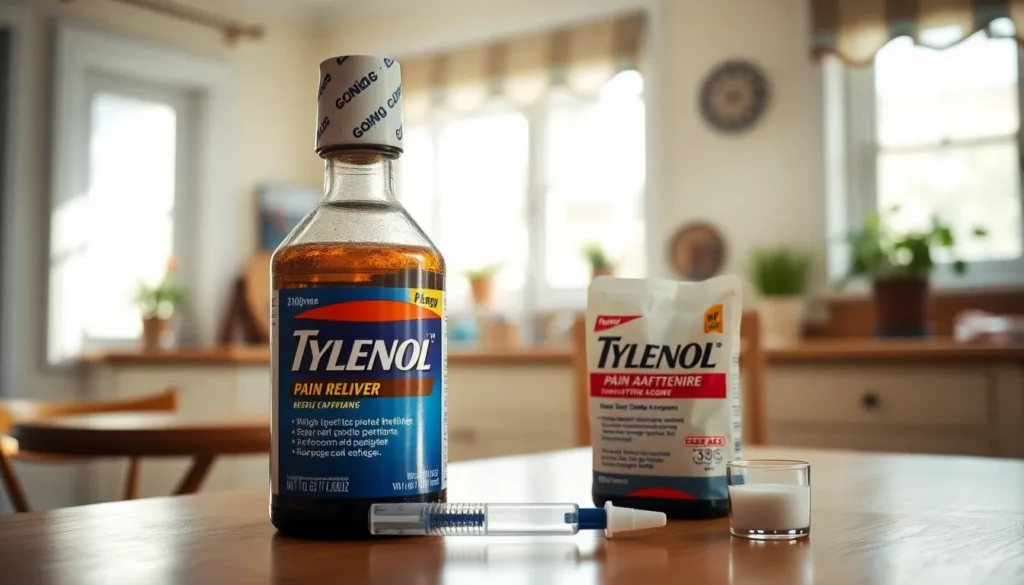When life throws a curveball—hello, headache, fever, or that pesky toothache—Tylenol often swoops in like a superhero. But how much of this trusty pain reliever can one safely take in a single day? It’s a question that deserves a spotlight, especially since nobody wants to be the star of a cautionary tale involving too much acetaminophen.
Table of Contents
ToggleUnderstanding Tylenol Dosage
Tylenol serves as a widely accepted pain reliever. Proper understanding of its dosage is crucial for safe use.
Recommended Dosage Guidelines
Adults typically take 500 mg to 1000 mg every four to six hours. Each day, a maximum of 4000 mg is advisable for most adults. For children, dosing depends on age and weight, following instructions on the label or those provided by a healthcare professional. Furthermore, using the smallest effective dose may minimize risks. Always consult with a healthcare provider for personalized guidance.
Maximum Daily Limit
The maximum daily limit for acetaminophen stands at 4000 mg for adults. While some individuals may rely on lower doses for chronic pain, steady intake should not exceed this threshold. Overdosing can lead to severe liver damage and other health issues. Monitoring intake, especially when using multiple medications containing acetaminophen, remains essential. Individuals with liver problems should seek advice regarding dosage adjustments.
Factors Affecting Dosage

Understanding dosage requires consideration of various factors. Age and weight significantly influence the amount of Tylenol someone can safely take.
Age and Weight Considerations
Children often require different dosages than adults due to their smaller body size. For infants and young children, dosing calculations rely on weight, with specific guidelines provided for each age group. Adults typically take higher doses, with the recommended amount ranging from 500 mg to 1000 mg every four to six hours. An individual’s weight can affect how acetaminophen is metabolized, making it crucial to adjust dosages accordingly, especially for those who are heavier or lighter than average.
Health Conditions and Medications
Specific health conditions can alter safe dosage levels. Individuals with liver disease must follow stricter dosage guidelines due to the organ’s reduced ability to process acetaminophen. Additionally, various medications may contain acetaminophen, amplifying the risk of overdose when taken together. It’s essential to monitor all sources of acetaminophen, ensuring the total daily intake does not exceed the recommended maximum. Regular consultations with healthcare professionals provide personalized advice tailored to individual health circumstances.
Signs of Tylenol Overdose
Tylenol overdose poses serious health risks. Recognizing the signs quickly is crucial for effective intervention.
Symptoms to Watch For
Nausea and vomiting frequently occur after an overdose. Abdominal pain can indicate significant liver distress. Additionally, loss of appetite may develop, leading to weight loss. Confusion or unusual fatigue often signals a severe reaction too. Dark urine or pale stools should raise immediate concerns, as they suggest liver impairment. Furthermore, jaundice, or yellowing of the skin and eyes, is a critical symptom to monitor.
When to Seek Medical Attention
Immediate medical help is vital if an overdose is suspected. Contact healthcare professionals if any symptoms arise, especially if they worsen. Emergency assistance is necessary for pronounced symptoms like severe abdominal pain or confusion. Individuals can also call poison control for guidance. Reporting Tylenol intake, including dosage and timing, aids professionals in providing appropriate care. Timeliness in seeking help can significantly impact recovery outcomes.
Safe Usage Tips
Safe usage of Tylenol hinges on accurate dosage and responsible administration. Following the guidelines set by healthcare professionals minimizes the risks associated with acetaminophen.
Proper Measuring Techniques
Measuring Tylenol accurately prevents unintentional overdose. Using a proper measuring device, such as a syringe or dosing cup, ensures precision. Individuals should avoid using household spoons, which may not provide accurate measurements. Check the label for specific dosage instructions based on age and weight. Consistently adhering to these techniques supports safe usage and effective pain management.
Importance of Following Instructions
Following Tylenol’s instructions is vital for safe consumption. Adhering to the recommended dosage limits helps avoid potential health complications. Adults typically should not exceed 4000 mg daily, while children’s doses depend on their weight. It’s crucial to read product labels carefully to identify any additional acetaminophen in combination medications. Consulting healthcare professionals about concerns or questions fosters better understanding and responsible use.
Understanding the appropriate dosage of Tylenol is essential for safe and effective pain relief. Adhering to recommended guidelines helps prevent potential risks associated with overdosing. It’s crucial to monitor all sources of acetaminophen, especially when using multiple medications, to avoid severe health consequences.
Regular consultations with healthcare professionals can provide tailored advice based on individual health needs. By being vigilant about dosage and using proper measuring tools, individuals can ensure responsible and safe consumption of Tylenol. Remember that when in doubt, seeking medical guidance is always the best course of action.










